Chenyu Liu
FB-4D: Spatial-Temporal Coherent Dynamic 3D Content Generation with Feature Banks
Mar 26, 2025Abstract:With the rapid advancements in diffusion models and 3D generation techniques, dynamic 3D content generation has become a crucial research area. However, achieving high-fidelity 4D (dynamic 3D) generation with strong spatial-temporal consistency remains a challenging task. Inspired by recent findings that pretrained diffusion features capture rich correspondences, we propose FB-4D, a novel 4D generation framework that integrates a Feature Bank mechanism to enhance both spatial and temporal consistency in generated frames. In FB-4D, we store features extracted from previous frames and fuse them into the process of generating subsequent frames, ensuring consistent characteristics across both time and multiple views. To ensure a compact representation, the Feature Bank is updated by a proposed dynamic merging mechanism. Leveraging this Feature Bank, we demonstrate for the first time that generating additional reference sequences through multiple autoregressive iterations can continuously improve generation performance. Experimental results show that FB-4D significantly outperforms existing methods in terms of rendering quality, spatial-temporal consistency, and robustness. It surpasses all multi-view generation tuning-free approaches by a large margin and achieves performance on par with training-based methods.
PHGNN: A Novel Prompted Hypergraph Neural Network to Diagnose Alzheimer's Disease
Mar 18, 2025Abstract:The accurate diagnosis of Alzheimer's disease (AD) and prognosis of mild cognitive impairment (MCI) conversion are crucial for early intervention. However, existing multimodal methods face several challenges, from the heterogeneity of input data, to underexplored modality interactions, missing data due to patient dropouts, and limited data caused by the time-consuming and costly data collection process. In this paper, we propose a novel Prompted Hypergraph Neural Network (PHGNN) framework that addresses these limitations by integrating hypergraph based learning with prompt learning. Hypergraphs capture higher-order relationships between different modalities, while our prompt learning approach for hypergraphs, adapted from NLP, enables efficient training with limited data. Our model is validated through extensive experiments on the ADNI dataset, outperforming SOTA methods in both AD diagnosis and the prediction of MCI conversion.
Col-OLHTR: A Novel Framework for Multimodal Online Handwritten Text Recognition
Feb 10, 2025Abstract:Online Handwritten Text Recognition (OLHTR) has gained considerable attention for its diverse range of applications. Current approaches usually treat OLHTR as a sequence recognition task, employing either a single trajectory or image encoder, or multi-stream encoders, combined with a CTC or attention-based recognition decoder. However, these approaches face several drawbacks: 1) single encoders typically focus on either local trajectories or visual regions, lacking the ability to dynamically capture relevant global features in challenging cases; 2) multi-stream encoders, while more comprehensive, suffer from complex structures and increased inference costs. To tackle this, we propose a Collaborative learning-based OLHTR framework, called Col-OLHTR, that learns multimodal features during training while maintaining a single-stream inference process. Col-OLHTR consists of a trajectory encoder, a Point-to-Spatial Alignment (P2SA) module, and an attention-based decoder. The P2SA module is designed to learn image-level spatial features through trajectory-encoded features and 2D rotary position embeddings. During training, an additional image-stream encoder-decoder is collaboratively trained to provide supervision for P2SA features. At inference, the extra streams are discarded, and only the P2SA module is used and merged before the decoder, simplifying the process while preserving high performance. Extensive experimental results on several OLHTR benchmarks demonstrate the state-of-the-art (SOTA) performance, proving the effectiveness and robustness of our design.
SelectiveFinetuning: Enhancing Transfer Learning in Sleep Staging through Selective Domain Alignment
Jan 07, 2025Abstract:In practical sleep stage classification, a key challenge is the variability of EEG data across different subjects and environments. Differences in physiology, age, health status, and recording conditions can lead to domain shifts between data. These domain shifts often result in decreased model accuracy and reliability, particularly when the model is applied to new data with characteristics different from those it was originally trained on, which is a typical manifestation of negative transfer. To address this, we propose SelectiveFinetuning in this paper. Our method utilizes a pretrained Multi Resolution Convolutional Neural Network (MRCNN) to extract EEG features, capturing the distinctive characteristics of different sleep stages. To mitigate the effect of domain shifts, we introduce a domain aligning mechanism that employs Earth Mover Distance (EMD) to evaluate and select source domain data closely matching the target domain. By finetuning the model with selective source data, our SelectiveFinetuning enhances the model's performance on target domain that exhibits domain shifts compared to the data used for training. Experimental results show that our method outperforms existing baselines, offering greater robustness and adaptability in practical scenarios where data distributions are often unpredictable.
Towards Wireless-Native Big AI Model: Insights into Its Ambitions, Peculiarities and Methodologies
Dec 12, 2024Abstract:Researches on leveraging big artificial intelligence model (BAIM) technology to drive the intelligent evolution of wireless networks are emerging. However, since the breakthrough in generalization brought about by BAIM techniques mainly occurs in natural language processing, there is still a lack of a clear technical roadmap on how to efficiently apply BAIM techniques to wireless systems with many additional peculiarities. To this end, this paper first reviews recent research works on BAIM for wireless and assesses the current research situation. Then, this paper analyzes and compares the differences between language intelligence and wireless intelligence on multiple levels, including scientific foundations, core usages, and technical details. It highlights the necessity and scientific significance of developing BAIM technology in a wireless-native way, as well as new issues that need to be considered in specific technical implementation. Finally, by synthesizing the evolutionary laws of language models with the particularities of wireless system, this paper provides several instructive methodologies for how to develop wireless-native BAIM.
BiT-MamSleep: Bidirectional Temporal Mamba for EEG Sleep Staging
Nov 03, 2024



Abstract:In this paper, we address the challenges in automatic sleep stage classification, particularly the high computational cost, inadequate modeling of bidirectional temporal dependencies, and class imbalance issues faced by Transformer-based models. To address these limitations, we propose BiT-MamSleep, a novel architecture that integrates the Triple-Resolution CNN (TRCNN) for efficient multi-scale feature extraction with the Bidirectional Mamba (BiMamba) mechanism, which models both short- and long-term temporal dependencies through bidirectional processing of EEG data. Additionally, BiT-MamSleep incorporates an Adaptive Feature Recalibration (AFR) module and a temporal enhancement block to dynamically refine feature importance, optimizing classification accuracy without increasing computational complexity. To further improve robustness, we apply optimization techniques such as Focal Loss and SMOTE to mitigate class imbalance. Extensive experiments on four public datasets demonstrate that BiT-MamSleep significantly outperforms state-of-the-art methods, particularly in handling long EEG sequences and addressing class imbalance, leading to more accurate and scalable sleep stage classification.
DAWN: Dynamic Frame Avatar with Non-autoregressive Diffusion Framework for Talking Head Video Generation
Oct 17, 2024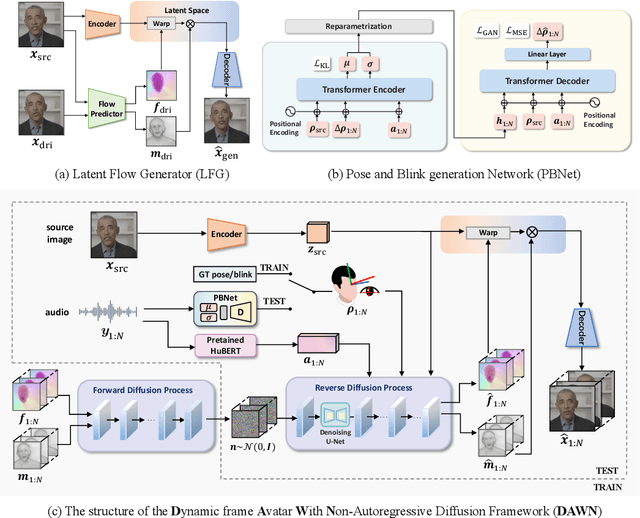
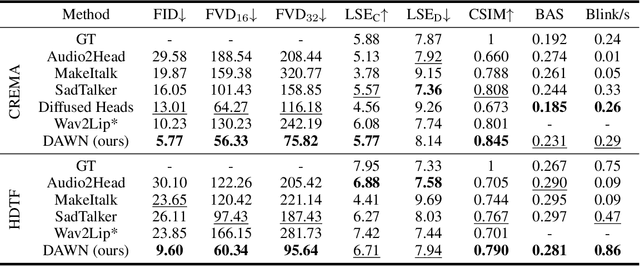


Abstract:Talking head generation intends to produce vivid and realistic talking head videos from a single portrait and speech audio clip. Although significant progress has been made in diffusion-based talking head generation, almost all methods rely on autoregressive strategies, which suffer from limited context utilization beyond the current generation step, error accumulation, and slower generation speed. To address these challenges, we present DAWN (Dynamic frame Avatar With Non-autoregressive diffusion), a framework that enables all-at-once generation of dynamic-length video sequences. Specifically, it consists of two main components: (1) audio-driven holistic facial dynamics generation in the latent motion space, and (2) audio-driven head pose and blink generation. Extensive experiments demonstrate that our method generates authentic and vivid videos with precise lip motions, and natural pose/blink movements. Additionally, with a high generation speed, DAWN possesses strong extrapolation capabilities, ensuring the stable production of high-quality long videos. These results highlight the considerable promise and potential impact of DAWN in the field of talking head video generation. Furthermore, we hope that DAWN sparks further exploration of non-autoregressive approaches in diffusion models. Our code will be publicly at https://github.com/Hanbo-Cheng/DAWN-pytorch.
See then Tell: Enhancing Key Information Extraction with Vision Grounding
Sep 29, 2024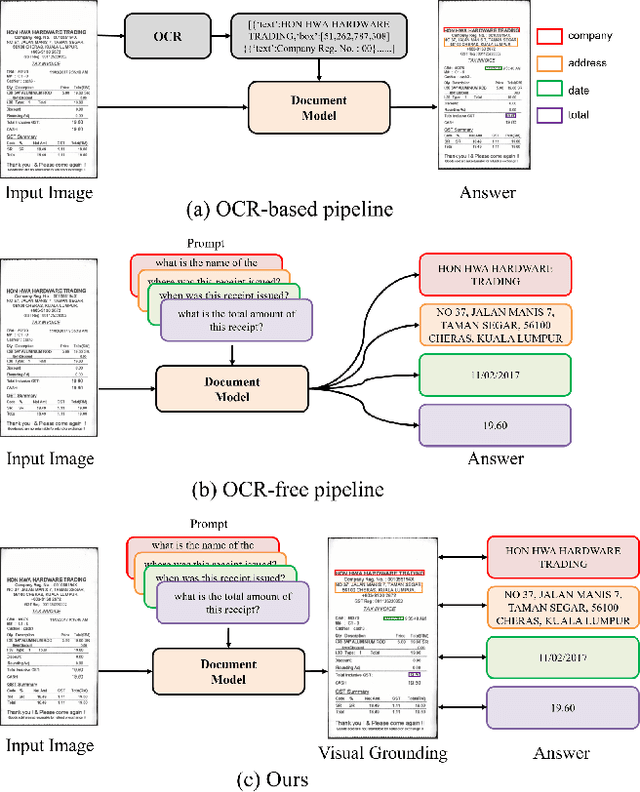
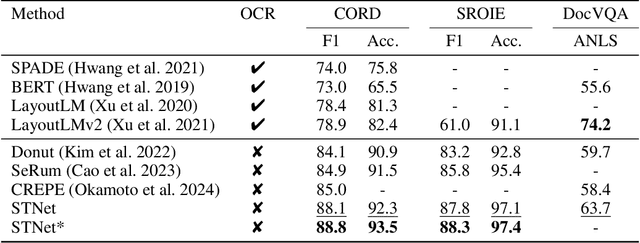
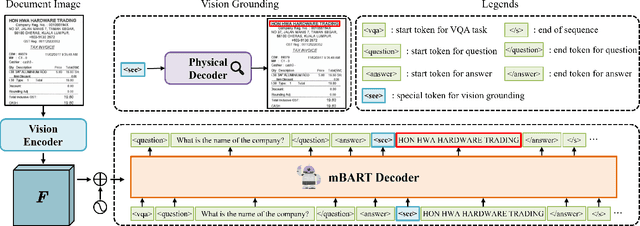

Abstract:In the digital era, the ability to understand visually rich documents that integrate text, complex layouts, and imagery is critical. Traditional Key Information Extraction (KIE) methods primarily rely on Optical Character Recognition (OCR), which often introduces significant latency, computational overhead, and errors. Current advanced image-to-text approaches, which bypass OCR, typically yield plain text outputs without corresponding vision grounding. In this paper, we introduce STNet (See then Tell Net), a novel end-to-end model designed to deliver precise answers with relevant vision grounding. Distinctively, STNet utilizes a unique <see> token to observe pertinent image areas, aided by a decoder that interprets physical coordinates linked to this token. Positioned at the outset of the answer text, the <see> token allows the model to first see--observing the regions of the image related to the input question--and then tell--providing articulated textual responses. To enhance the model's seeing capabilities, we collect extensive structured table recognition datasets. Leveraging the advanced text processing prowess of GPT-4, we develop the TVG (TableQA with Vision Grounding) dataset, which not only provides text-based Question Answering (QA) pairs but also incorporates precise vision grounding for these pairs. Our approach demonstrates substantial advancements in KIE performance, achieving state-of-the-art results on publicly available datasets such as CORD, SROIE, and DocVQA. The code will also be made publicly available.
A Comprehensive Survey on EEG-Based Emotion Recognition: A Graph-Based Perspective
Aug 13, 2024Abstract:Compared to other modalities, electroencephalogram (EEG) based emotion recognition can intuitively respond to emotional patterns in the human brain and, therefore, has become one of the most focused tasks in affective computing. The nature of emotions is a physiological and psychological state change in response to brain region connectivity, making emotion recognition focus more on the dependency between brain regions instead of specific brain regions. A significant trend is the application of graphs to encapsulate such dependency as dynamic functional connections between nodes across temporal and spatial dimensions. Concurrently, the neuroscientific underpinnings behind this dependency endow the application of graphs in this field with a distinctive significance. However, there is neither a comprehensive review nor a tutorial for constructing emotion-relevant graphs in EEG-based emotion recognition. In this paper, we present a comprehensive survey of these studies, delivering a systematic review of graph-related methods in this field from a methodological perspective. We propose a unified framework for graph applications in this field and categorize these methods on this basis. Finally, based on previous studies, we also present several open challenges and future directions in this field.
NAMER: Non-Autoregressive Modeling for Handwritten Mathematical Expression Recognition
Jul 16, 2024Abstract:Recently, Handwritten Mathematical Expression Recognition (HMER) has gained considerable attention in pattern recognition for its diverse applications in document understanding. Current methods typically approach HMER as an image-to-sequence generation task within an autoregressive (AR) encoder-decoder framework. However, these approaches suffer from several drawbacks: 1) a lack of overall language context, limiting information utilization beyond the current decoding step; 2) error accumulation during AR decoding; and 3) slow decoding speed. To tackle these problems, this paper makes the first attempt to build a novel bottom-up Non-AutoRegressive Modeling approach for HMER, called NAMER. NAMER comprises a Visual Aware Tokenizer (VAT) and a Parallel Graph Decoder (PGD). Initially, the VAT tokenizes visible symbols and local relations at a coarse level. Subsequently, the PGD refines all tokens and establishes connectivities in parallel, leveraging comprehensive visual and linguistic contexts. Experiments on CROHME 2014/2016/2019 and HME100K datasets demonstrate that NAMER not only outperforms the current state-of-the-art (SOTA) methods on ExpRate by 1.93%/2.35%/1.49%/0.62%, but also achieves significant speedups of 13.7x and 6.7x faster in decoding time and overall FPS, proving the effectiveness and efficiency of NAMER.
 Add to Chrome
Add to Chrome Add to Firefox
Add to Firefox Add to Edge
Add to Edge